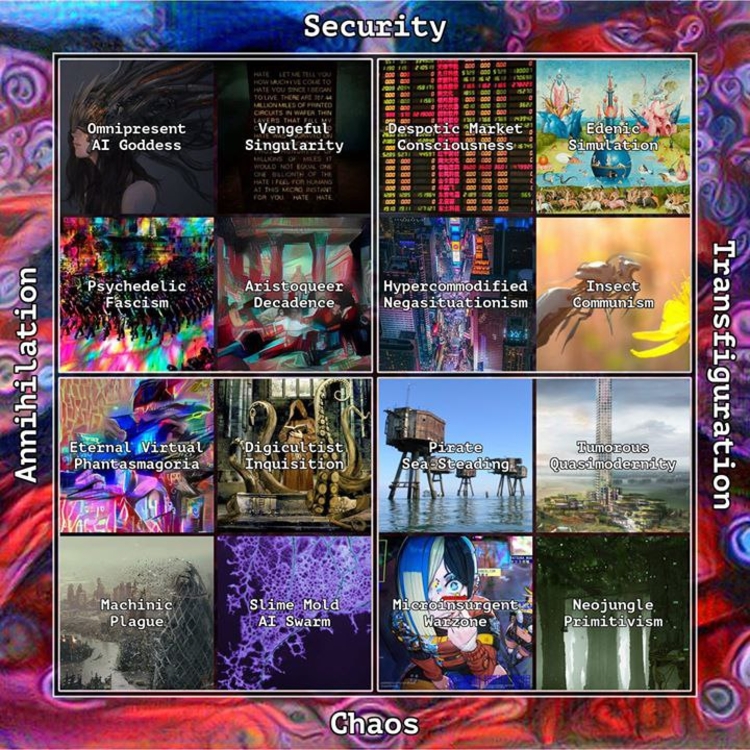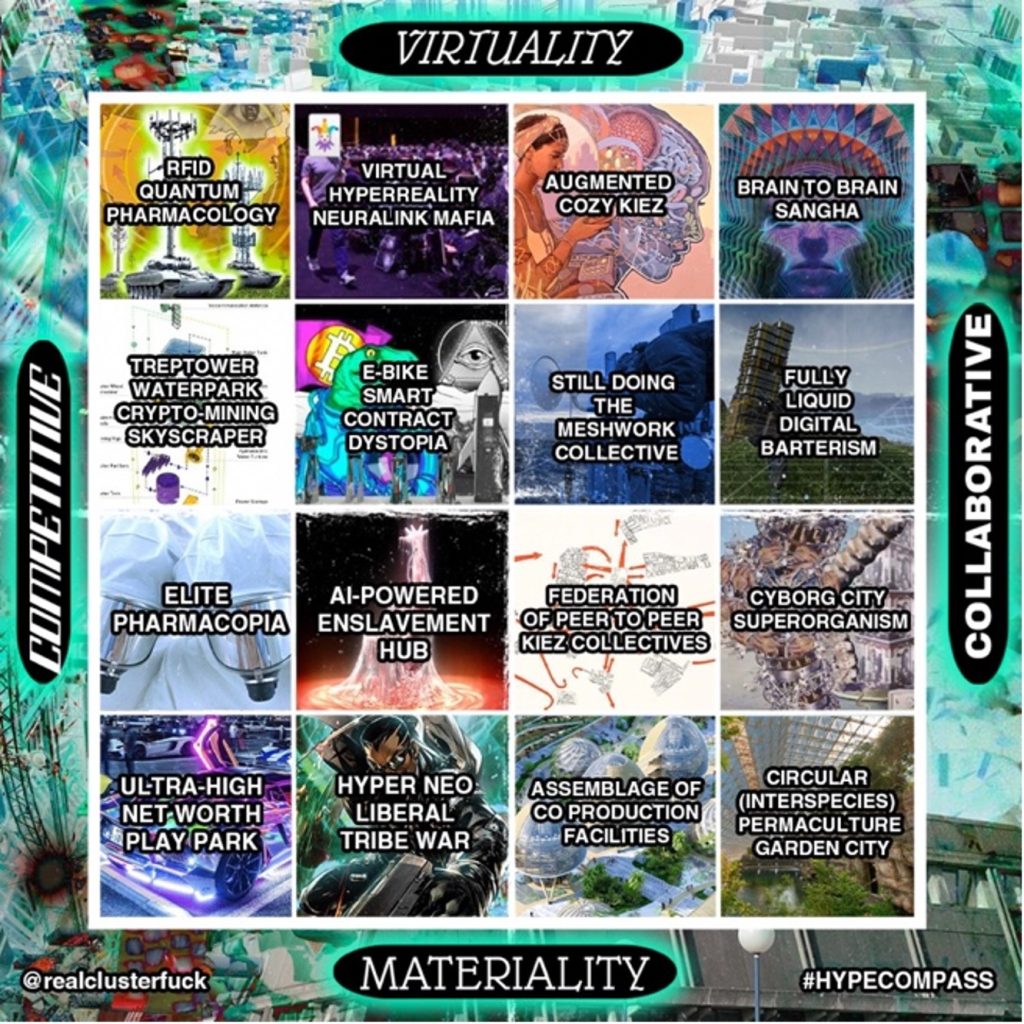
Materializing Alternative Futures through Urban Hyperstitions: The Case of Haus der Statistik in Berlin
– Noël Nicolaus
“It’s easier to imagine the end of the world than the end of capitalism”: this aphorism may be one of the most iconic descriptions of the contemporary Zeitgeist, as testified by its multiple iterations and apocryphal attributions1. Its success shows how the socio-cultural developments of the past four decades have left us incapable – or unwilling – to create radical counter-imaginaries that can serve as templates for alternative futures, and therefore as viable blueprints for radical political action. Collectively and as a civilization, it often feels as if we are facing a wall, a metaphysical barrier of sorts, preventing us from seeing a future that is not made up of ruins2 or of the many ghosts of its long-gone past versions3.
This obliteration of collective imagination has permeated even the most trivial forms of social gossip, as shown by the blasé commentaries on late capitalism that cosmopolitan urbanites exchange at parties and social gatherings. Gentrification of once run-down neighbourhoods is here always implied as an inescapable phenomenon, a naturalized, innate tendency of the urban metabolism. The only room left for speculation concerns where it will hit next: Berlin being long lost and Lisbon on the fast lane of total commercialization, where to go now? Belgrade? Sofia? …Kiev? Where can global capital be outrun for long enough as to enjoy a glimpse of authentic urban bohemia4?
This article is an attempt to counter these defeatist, cynical tendencies. It presents both a practical example that goes against this widespread perception and proposes a collaborative practice for imagining alternative urban futures. The presented example is the grassroots urban project Haus der Statistik, located in the heart of Berlin, just a few hundred meters from the central Alexanderplatz. The proposed practice is a collective memetic workshop called Hypecompass, created by the international research collective Clusterduck and presented at Haus der Statistik in summer 2020. To understand both, it is first necessary to introduce the notion of urban hyperstition and illustrate its power by recounting the history of another peculiar Berlin building, the recently inaugurated Humboldt Forum.
Hyperstitions as a tool for urban evocation: the example of the reconstructed Berlin City Palace
The concept of hyperstition was originally brought forward by the controversial Cybernetic Culture Research Unit (CCRU) which existed at Warwick University, UK, from 1995 to 1997. Loosely speaking, hyperstitions can be defined as “fictions that make themselves real”5. “By writing a universe, the writer makes such a universe possible”6, the CCRU states. Accordingly, the same might be said of speculative futures: by picturing a scenario, in a very broad sense we are taking the first step towards its realization.
If we apply this concept to urban studies – or, even better, to urban activism – it turns out to be a powerful tool. In order to properly grasp its potential, it’s important to distinguish it from mere urban planning. Where the latter usually comes into play once the social, political and economic conditions for its implementation are already in place7, urban hyperstitions start by presenting the final stage of planning as a fait accompli, basically pretending that the project is already being realized or, even better, already finished. In this regard, they also differ from utopian urban planning, which from the onset presents itself as speculative.
Berlin, with its possibly unique density of deeply conflicting urban imaginaries and architectonic simulacra, gives us two excellent examples of such a use of hyperstitional technology: one reactionary and one progressive. The recently reconstructed Berliner Stadtschloss arguably belongs to the first category8. As is known, the original baroque city palace, which served as template for the new building, was razed shortly after the end of the Second World War by East German authorities, eager to set a tangible sign of the old regime’s demise (and despite the perfectly salvageable condition of the venerable Schloss). Ironically, in order to make way for its reconstruction, the building that had taken its place, the now legendary Palast der Republik – a multifunction modernist behemoth that hosted the German Democratic Republic’s Parliament as well as a multitude of other public spaces9 – also had to be obliterated.
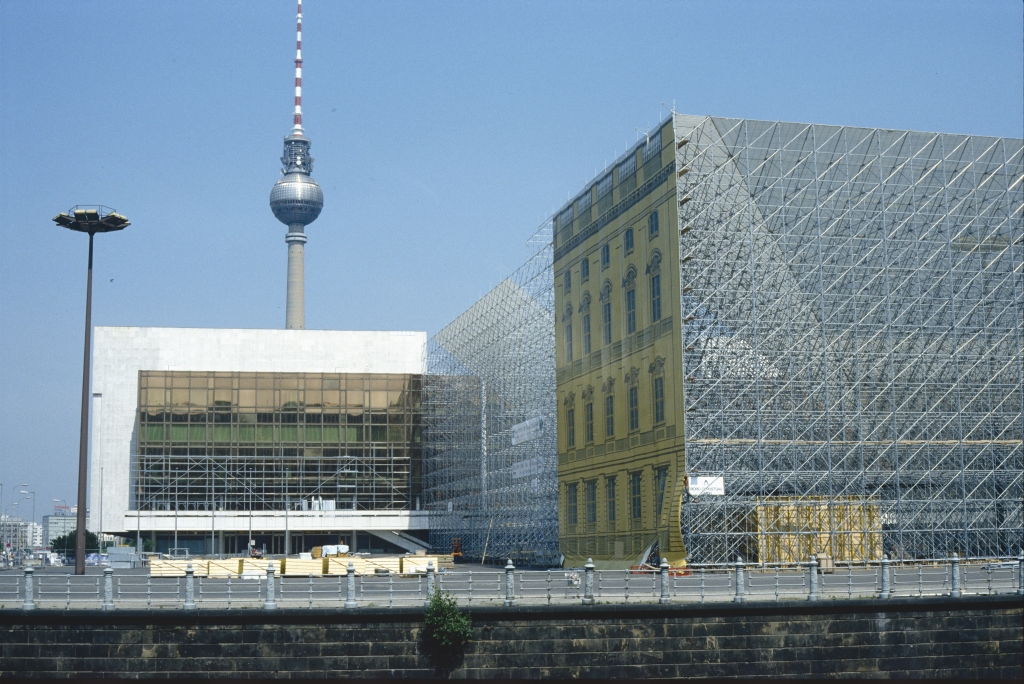
Image 1. Evoking ghosts through urban hyperstitions: the replica of the Stadtschloss in front of the Palast der Republik during construction. Source: Robert Engelhardt – http://stock.diskurse.net/.

Image 2. Evoking ghosts through urban hyperstitions: the replica of the Stadtschloss in front of the Palast der Republik after completition. Source: Robert Schediwy.
What is less well known, is that the reconstruction of the Stadtschloss probably wouldn’t have happened without a pretty daring hyperstitional stunt performed by Willhelm Von Boddien, a Pomeranian businessman who may be described as the main force behind the reconstruction process. In 1993, through a grassroots private initiative, Von Boddien channelled enough financial resources to install a giant trompe l’oeil in front of the Palast der Republik: a 1:1 replica of the former baroque city palace, placed in the exact same spot where the original building used to be. The operation proved immensely effective, leaving a lasting impression on Berlin’s public and evoking a ghost so powerful that two international architectural competitions, featuring the best architects of those years, weren’t able to dispel it. Arguably, the now realized replica is a result of that operation.
The short story of Haus der Statistik, or: How to convince your city to spend 50 Million Euros on an abandoned communist building
The second example is what we might consider the progressive pendant of the Stadtschloss, a project called Haus der Statistik (HdS). Fittingly, it is located in a huge building complex that once used to house the East German government’s Central Office for Statistics (Staatliche Zentralverwaltung für Statistik, SZS – hence the name HdS). The complex was originally built as part of the GDR’s reshaping of Berlin as Hauptstadt der DDR [Capital of the GDR], a gargantuan urbanistic effort aimed at displaying the technocratic beliefs of the regime. The result was a unique ensemble of modernist buildings and monumental open spaces, the most famous of which is probably the Sputnik-like Fernsehturm. After the fall of the Berlin Wall, an immediate process of damnatio memoriae of this heritage set in, with many buildings demolished and the original openness of the public spaces forever destroyed by accelerated densification and privatization.
Today, the area around Alexanderplatz is a peculiar mixture of socialist and capitalist city planning, suspended in an undefined state. During the past decade, a change in public sensibilities and an according shift in local politics has led to a re-evaluation of the communist architectonic heritage, with many buildings originally slated for demolition gaining protected status – an understandable decision, considering the largely disappointing outcome of the post-GDR transformations. In this cultural climate, and during a time of unprecedented pressure on the city’s famed artistic community, an alliance of endangered art spaces took the initiative and reclaimed the long-abandoned Haus der Statistik as an urban commons. To do it, they used the power of hyperstition: in September 2015, they covered a huge, highly visible section of the building’s façade with a giant poster. “Here, spaces for artistic, cultural and social initiatives are being created for Berlin”, the poster announced in large red letters. Below: the institutional epitaph “Supported by”, followed by the logo of the artists’ initiative, the official Berlin city signet, the flag of the EU and the seal of the German Federal Ministry of Culture. To the untrained eye or the casual flaneur, the poster could easily pass as a “real” (i.e. “official” and politically approved) artefact.
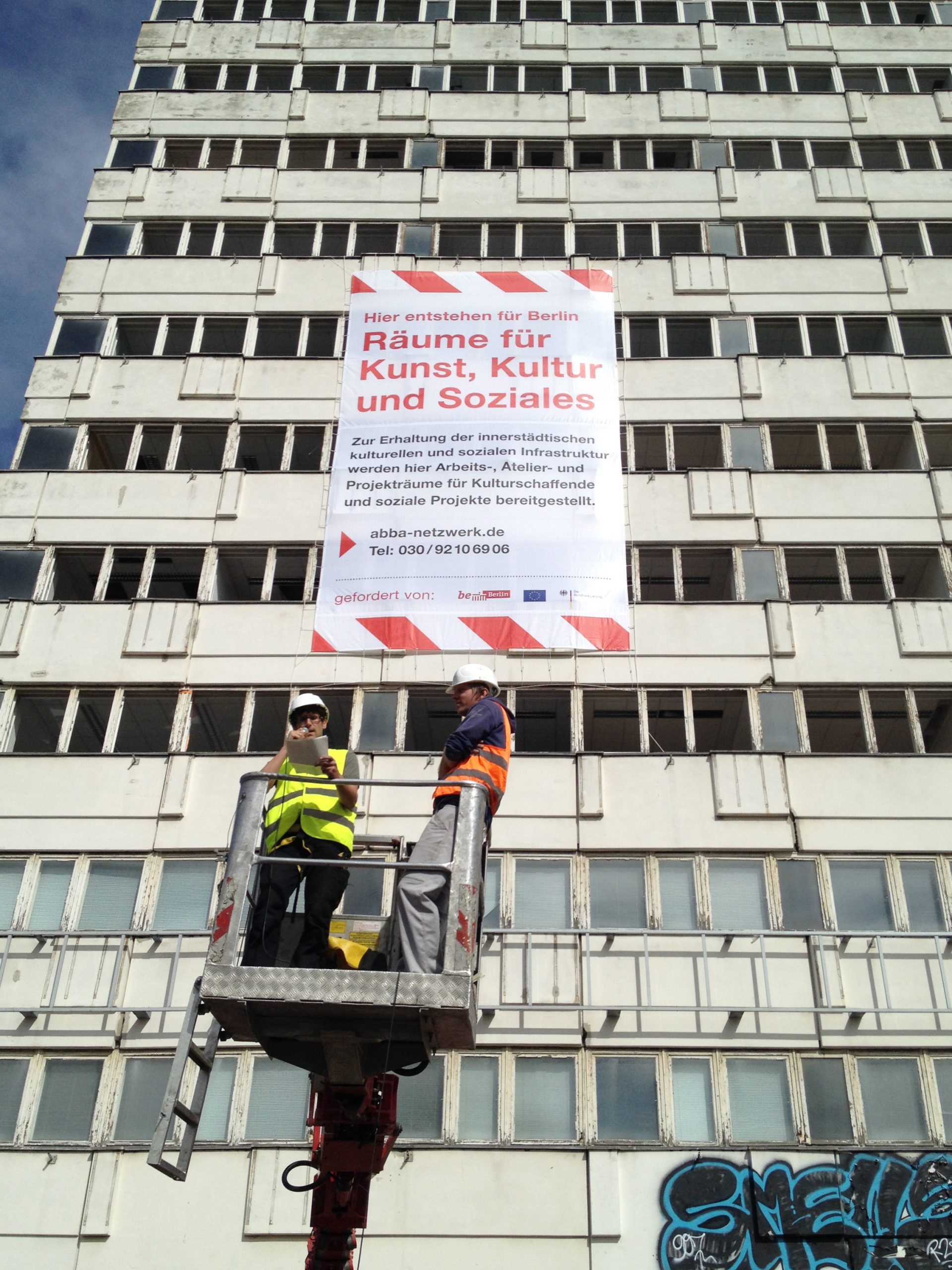
Image 3. Hyperstitions as a tool for urban activism: the poster that started everything. Source: AbBA.
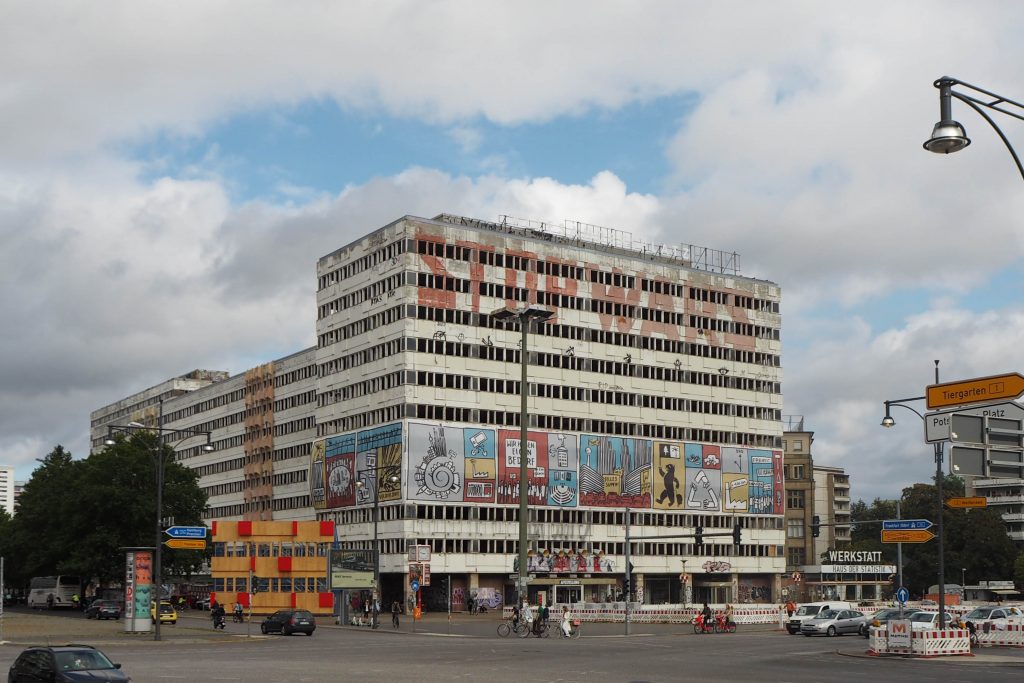
Image 4. Hyperstitions as a tool for urban activism: the main building of Haus der Statistik as seen from Alexanderplatz. Source: ZKB eG.
Just like in the case of Von Boddien’s fake Schloss-facades more than two decades earlier, the gravitational power of the alternate reality materialized by the poster proved irresistible. Against all odds, the city administration felt compelled to take Haus der Statistik into its real estate portfolio, buying it from Federal Authorities for a price estimated at around 50 million Euros, and decided to cancel its planned demolition and replacement by high-end office spaces.
Today, the 46.000 square meter complex is set for a mixed-use redevelopment, which will include spaces for artists, public housing, offices for the city administration and spaces for refugees10. The masterplan was developed through participative planning, with a strong inclusion of the grassroot initiatives that kicked off the whole process. Significantly, campaigners and political actors alike agreed that the project should have ‘model character’ (Modellcharakter) for future initiatives. In a city that is increasingly engrossed by fear about the inevitability of gentrification, Haus der Statistik represents a strong rebuke to those who doubt that “another city is possible”, to paraphrase a successful slogan of the early 2000s altermondialist movements.
Using memetics to develop speculative urban scenarios: A brief recount of Clusterduck’s Hypecompass Workshop at Haus der Statistik
During the short pandemic summer of 2020, we11 – that is, the transmedia research collective Clusterduck – had the opportunity to hold a collective workshop at HdS during our Pioniernutzung12. We think that a short recount of that experience might represent a fitting end for this short reflection on the power of urban hyperstitions, since the concept played a crucial role in the workshop as well.
In July 2020, following an open application process, we were offered the chance to use one of the rooms of the huge main building for a month-long residency. We used the small space to showcase our collective’s current research projects, organizing a meme-themed exhibition and some small public get-togethers. Meanwhile, in the rooms around us, a multitude of activities was unfolding. These included, among other things, a queer-themed week of events, public DIY laboratories, discussion groups about racism and the BLM movement, a weekly get-together of Burning Man-aficionados and the inauguration of a space for makers and sustainable economies.
During those weeks, despite all the challenges and limitations deriving from a global pandemic, Haus der Statistic seemed to us like the living embodiment of a true urban commons – that is, an open, permeable space, susceptible to spontaneous interventions and open to many heterogeneous user groups. Inspired by this stimulating, optimistic atmosphere, for the closing of our residency we decided to adapt a workshop we had developed some months earlier – the ‘Hypecompass Workshop’.
When we first performed the workshop in September 2019 at the digital arts and culture festival ‘The Influencers’ in Barcelona, a global pandemic seemed a far-fetched disaster-movie scenario, and US President Trump still had good prospects of being re-elected for a second term. Large mass demonstrations in Hong Kong, Lebanon and Chile were attracting attention all over the world, and a new cycle of social movements seemed ready to take the global stage.
We had decided to take inspiration from a relatively new, niche meme format, usually representing two opposing couples of values along an X/Y graph. These created a matrix of 16 squares, showing different speculative scenarios, and were often accompanied by the phrase “choose your future”.
The format was an evolution of the more popular ‘Political Compass’ meme format, which is often used by online activists to ironically comment on contemporary political (sub)cultures. We thought that the ‘Choose your Future’ format had enormous potential, since – while wildly speculative – it showed in a visually compelling way that our future is an open path with many potential outcomes, both positive and negative, thus helping to counter the still dominating neoliberal TINA13-narrative. We decided to join this visual format with the concept of hyperstition – and voilà, the Hypecompass was born!
Through a series of group activities and exercises, we helped workshop participants to channel their personal visions of the future into their own version of the ‘Choose your Future’ meme. The results from Barcelona were so hilarious and inspiring that we couldn’t resist the temptation to replicate the format in such a powerful hyperstitional space as HdS. For the Berlin edition of the workshop, we thus decided to focus exclusively on the urban context in which we and the participants were embedded: the result, shown below, can be seen as a tongue-in-cheek memetic representation of Berlin’s (possible) futures.
Outlook: Let a hundred urban utopias bloom!
The two main couples of values identified by the participants were virtuality/materiality and collaborative/competitive – an interesting choice, considering the strong influence of Berlin’s rising start-up scene on the city’s economy and the deep involvement with digital technologies of many Gen Y and Gen Z urbanites. The proposed scenarios differed wildly, bearing evocative titles such as “Treptower Waterpark Crypto-Mining Skyscraper” or “Circular (Interspecies) Permaculture Garden-City”. Some tried to incorporate elements typical of Berlin’s urban culture, referring to the city’s peculiar neighbourhood notion of the “Kiez” (a concept somehow comparable to New York’s urban villages), while others went fully dystopian (“Hyper Neo-Liberal Tribe War”, “AI-Powered Enslavement Hub”).
Although we wouldn’t suggest these scenarios as viable blueprints for city policies – far from it! – we think that the collective exercises that produced them can help us regain some of the capacity for speculation and imaginative planning that seems so lacking in these dire times, contributing to open up our way of thinking about the future of cities. While we subscribe to critiques denouncing the dangers of magical thinking – there is no way to “wish away” gentrification, let alone the existential threat posed by the COVID-pandemic or climate change – we also think that we need to broaden the scope of our common semantic field. Without opening up the boundaries of our thinking and breaking the limits of our shared imaginaries, we won’t be able to find practical solutions to the multifaceted crises we are now facing as a species. In this sense, the playful deployment of speculative scenarios can be essential to recover the essence of utopian thinking – a crucial feat since, to use Jameson’s words, “it is difficult (…) to imagine any radical political programme (…) without the conception of systemic otherness, of an alternate society, which only the idea of utopia seems to keep alive, however feebly”14.

Image 8. ‘Hypecompass – Berlin Edition’ meme produced at Haus der Statistik in Berlin, July 2020. Source: Author – Clusterduck.
To come back to the example of Berlin, we need to foster discourses that show the possibility of a future beyond the supposedly inevitable “londonization” of the German capital (or any other city, including London itself). This can be done by focusing on projects like HdS, or on the many fights put forward by tenants and migrants over the past years. We have to analyse the political and practical conditions necessary for this sort of urban and political projects to succeed, building an archipelago of heterotopic alternatives15 capable of resisting the enormous financial powers that are currently (re)shaping our cities. We should look everywhere for possibilities to overturn the current neoliberal urban dogma: project by project, building by building, street by street. To succeed, we will have to use all tools at our disposal: from the more conventional ones, like Community Land Trusts, petitions or demonstrations, to the more unusual ones, like squatting, memetic guerrilla or urban hyperstitions. We will have to build unusual alliances, create resilient networks of grassroots institutions, foster models for sustainable circular economies. If we do this the right way, we might be able to replicate and multiply the more virtuous examples, creating an expanding network of urban commons which, in the best-case scenario, could tip the current balance of powers. It won’t be easy, but it’s a possibility – one among many, many others.
Notes
1. The late Marc Fisher, David Graeber and Slavoj Žižek have all at times – erroneously – been credited as sources of the highly successful one-liner. While they surely contributed to its popularization, its origins can be traced back to Frederic Jameson’s work. Interestingly enough, the original version recited: “Someone once said that it is easier to imagine the end of the world than to imagine the end of capitalism”, leaving the authorship question forever unanswered.
2. Campagna, F. (2021). Prophetic Culture. Recreation for Adolescents. London: Bloomsbury.
3. To understand our persistent infatuation with retrofuturism, be it the space utopias of the 1960s or the cyberpunk dystopias of the 1980s, it’s useful to draw on Marc Fisher’s interpretation of Deridda’s concept of ‘hauntology’. In Fisher’s eyes, since the 1990s “cultural time has folded back in on itself“, leading to a “slow cancellation of the future”.
Fisher, M. (2014). Ghosts of My Life: Writings on Depression, Hauntology and Lost Futures. Portland: Zero Books.
4. One might say that it’s easier to imagine the death of cosmopolitan urbanism than the end of gentrification.
5. CCRU (2017). Writings 1997-2004. Falmouth: Urbanomic, p. 35.
6. Ibid., p. 36.
7. Though, admittedly, these can often shift, resulting in a whole world of urban potentialities that never came into being.
Krohn, C. (2010). Das ungebaute Berlin: Stadtkonzepte im 20. Jahrhundert. Berlin: Dom publishers.
8. The “new” city palace, conveniently rebranded as Humboldt Forum, will host spaces for events and various museums, including the vast ethnological collection once displayed in Berlin-Dahlem. The project is at the center of an ongoing controversy due to the colonial origin of many artefacts.
9. Just like the original Stadtschloss, the Palast der Republik would have been perfectly salvageable, despite the official alarm about extensive asbestos-contamination (the huge, equally asbestos-infested congress center ICC, the West-Berlin cousin of the Palast, is still standing and set for extensive renovation works, despite the expected horrendous cost). In the last years before total demolition in the early 2000’s, the steel skeleton of the building, aptly renamed VolksPalast, hosted some of the most memorable cultural events of post-wall Berlin.
10. For more information, please visit the project’s website: https://hausderstatistik.org/
11. To learn more about our work, feel free to visit our website: http://clusterduck.space/
12. Pioniernützer is a German word which may be roughly translated as pioneer users. In this specific case, it defines a strategy enabling cultural and political actors to temporarily use the buildings and spaces in a formerly abandoned area.
13. TINA = There is no alternative. The acronym stands for the hegemonic neoliberal consensus that emerged from the Thatcher-Reagan era, and is a reference to a well-known one-liner used by the former British prime minister to justify her harsh and highly unpopular austerity measures.
14. Jameson, F. (2004). The Politics of Utopia. London: New Left Review.
15. French philosopher Michel Foucault defined heterotopias as the spaces of “otherness”. While heterotopias, in Foucault’s definition, can also be repressive spaces (such as prisons), they are nevertheless necessary for the realization of urban utopias, and a precious means to escape authoritarianism and repression. See Foucault, M. (October 1984). Des espaces autres. Architecture, mouvement, continuité. A translated version of Foucault’s original text can be found here: https://web.mit.edu/allanmc/www/foucault1.pdf
+
The Hypecompass Workshop presented in the article was part of Clusterduck’s “Pioniernutzung” at Haus der Statistik in Summer 2020.
Noël Nicolaus is an independent scholar and author living and working in Berlin. He has cofounded the international digital art collective Clusterduck, investigating processes and actors behind the creation of internet-related content. As a member of the collective, he has co-curated various exhibitions and events over the past five years, including the most recent project #MEMEMANIFESTO and the URL/IRL exhibition #MEMEPROPAGANDA. He has also published various articles on topics related to urban research, with special focus on the notion of citizenship in the urban context. As an activist he has participated in initiatives like MEGASPREE or Initiative Stadt Neu Denken, opposing the increasing commercialization and gentrification of Berlin. He is currently working as senior editor for the digital communications agency rethink.
Volume 4, no. 2 Summer 2021


